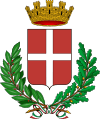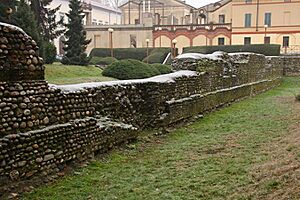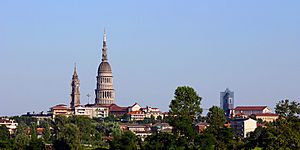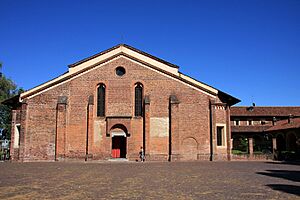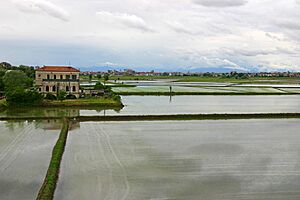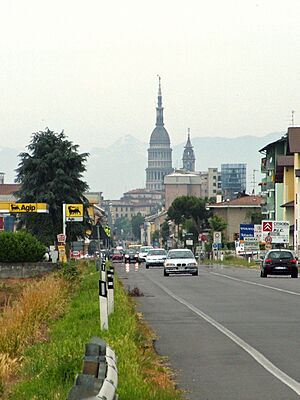Novara facts for kids
Quick facts for kids
Novara
|
|||
|---|---|---|---|
| Comune di Novara | |||
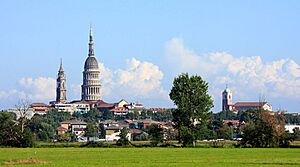
A panorama of Novara, showing the Basilica of San Gaudenzio, with its campanile and cupola, and Novara Cathedral
|
|||
|
|||
| Country | Italy | ||
| Region | Piedmont | ||
| Province | Novara (NO) | ||
| Frazioni | Lumellogno, Agognate, Bicocca Di Novara, Casalgiate, Olengo, Pernate, Sant'Agabio, Torrion Quartara, Veveri, Vignale, Gionzana, Pagliate | ||
| Area | |||
| • Total | 103.05 km2 (39.79 sq mi) | ||
| Elevation | 162 m (531 ft) | ||
| Population
(1 January 2021)
|
|||
| • Total | 101,916 | ||
| • Density | 989.00/km2 (2,561.49/sq mi) | ||
| Demonym(s) | Novarese(i) | ||
| Time zone | UTC+1 (CET) | ||
| • Summer (DST) | UTC+2 (CEST) | ||
| Postal code |
28100
|
||
| Dialing code | 0321 | ||
| Patron saint | Saint Gaudentius | ||
| Saint day | 22 January | ||
Novara is a city in northwest Italy. It is the capital of the province of Novara in the Piedmont region. Novara is located west of Milan. With over 100,000 people, it is the second largest city in Piedmont, after Turin.
Novara is an important place for trade and travel. It sits on major routes between Milan and Turin, and from Genoa to Switzerland. The city is found between two small rivers, the Agogna and Terdoppio. It is about 50 kilometers (31 miles) from Milan and 95 kilometers (59 miles) from Turin. The Ticino river, which forms the border with the Lombardy region, is only 15 kilometers (9 miles) away.
History of Novara
Novara was started by the Romans around 89 BC. At that time, the local Gauls, who lived there, became Roman citizens. The city's name comes from "Nov," meaning "new," and "Aria," which was the name the local Gauls used for the area.
The ancient city of Novaria existed even before the Romans, when the Ligures and Celts lived there. It was an important Roman town called a municipium. It was located on the road connecting Vercellae (now Vercelli) to Mediolanum (now Milan). The city's street layout, which is still visible today, was planned by the Romans.
Novara was destroyed in 386 by Magnus Maximus because it supported his enemy, Valentinian II. However, it was rebuilt by Theodosius I. Later, the city was attacked by Radagaisus in 405 and Attila in 452.
Under the Lombards, Novara became a duchy, which was a territory ruled by a duke. Later, under Charles the Fat, it became a countship, ruled by a count. Novara then gained special rights as a free imperial city, meaning it had some independence.
In 1110, Henry V conquered and destroyed Novara. But in 1167, the city joined the Lombard League, a group of northern Italian cities that fought for their freedom. By the late 1100s, Novara accepted protection from Milan. It became part of the lands controlled by the powerful Visconti family and later the Sforza family.
In the Battle of Novara in 1513, Swiss soldiers defended Novara for the Sforzas of Milan. They defeated the French army that was trying to take the city. This battle ended the French invasion of Italy during the War of the League of Cambrai.
In 1706, Novara was taken by troops from Savoy. The city, along with Milan, became part of the Habsburg Empire after the Peace of Utrecht. In 1735, after being occupied in 1734, Novara became part of the lands ruled by the House of Savoy.
After Napoleon's military campaigns in Italy, Novara became the capital of the Department of the Agogna. But in 1814, it was given back to the House of Savoy. In 1821, a battle took place in Novara where regular Sardinian troops defeated Piedmontese liberals who wanted a constitution.
A bigger battle, the Battle of Novara, happened in 1849. The Sardinian army was defeated by the Austrian army. This loss led to the king, Charles Albert of Sardinia, stepping down. It also led to the Austrians partly occupying Novara. This defeat is seen as the start of the Italian unification movement, which aimed to unite all of Italy.
In 1859, the province of Novara was created. It included areas that are now the provinces of Vercelli, Biella, and Verbano-Cusio-Ossola.
In 1861, Novara had about 25,000 people. As industries grew in the 20th century, the city's population increased. By 1981, it reached over 102,000 people. The population has stayed about the same since then.
Oscar Luigi Scalfaro, who later became a president of Italy, was born in Novara in 1918.
Climate
| Climate data for Novara, Cameri (1991–2020, extremes 1960–present) | |||||||||||||
|---|---|---|---|---|---|---|---|---|---|---|---|---|---|
| Month | Jan | Feb | Mar | Apr | May | Jun | Jul | Aug | Sep | Oct | Nov | Dec | Year |
| Record high °C (°F) | 20.7 (69.3) |
25.9 (78.6) |
28.6 (83.5) |
32.2 (90.0) |
33.7 (92.7) |
37.9 (100.2) |
38.3 (100.9) |
38.1 (100.6) |
37.8 (100.0) |
30.9 (87.6) |
22.2 (72.0) |
21.1 (70.0) |
38.3 (100.9) |
| Mean daily maximum °C (°F) | 6.8 (44.2) |
9.4 (48.9) |
14.4 (57.9) |
17.9 (64.2) |
22.3 (72.1) |
26.7 (80.1) |
29.1 (84.4) |
28.7 (83.7) |
24.1 (75.4) |
17.9 (64.2) |
11.6 (52.9) |
7.2 (45.0) |
18.0 (64.4) |
| Daily mean °C (°F) | 2.2 (36.0) |
3.9 (39.0) |
8.4 (47.1) |
12.2 (54.0) |
16.8 (62.2) |
21.1 (70.0) |
23.2 (73.8) |
22.9 (73.2) |
18.4 (65.1) |
13.1 (55.6) |
7.4 (45.3) |
2.8 (37.0) |
12.7 (54.9) |
| Mean daily minimum °C (°F) | −1.9 (28.6) |
−1.2 (29.8) |
2.5 (36.5) |
6.5 (43.7) |
11.2 (52.2) |
15.3 (59.5) |
17.3 (63.1) |
17.3 (63.1) |
13.1 (55.6) |
8.6 (47.5) |
3.4 (38.1) |
−1.1 (30.0) |
7.6 (45.7) |
| Record low °C (°F) | −19.4 (−2.9) |
−15.2 (4.6) |
−11.1 (12.0) |
−5.0 (23.0) |
−1.8 (28.8) |
3.2 (37.8) |
6.6 (43.9) |
4.5 (40.1) |
1.6 (34.9) |
−7.6 (18.3) |
−10.0 (14.0) |
−13.8 (7.2) |
−19.4 (−2.9) |
| Average precipitation mm (inches) | 41.10 (1.62) |
45.76 (1.80) |
46.87 (1.85) |
72.01 (2.84) |
93.25 (3.67) |
59.79 (2.35) |
43.73 (1.72) |
64.13 (2.52) |
80.75 (3.18) |
87.08 (3.43) |
112.24 (4.42) |
49.88 (1.96) |
796.59 (31.36) |
| Average precipitation days (≥ 1.0 mm) | 3.93 | 3.57 | 3.97 | 7.00 | 7.83 | 5.62 | 4.48 | 5.28 | 5.66 | 6.79 | 7.36 | 4.78 | 66.27 |
| Average relative humidity (%) | 78.16 | 72.08 | 67.77 | 68.09 | 69.44 | 69.04 | 68.03 | 69.66 | 71.17 | 77.04 | 80.53 | 79.76 | 72.56 |
| Source 1: NOAA | |||||||||||||
| Source 2: Servizio Meteorologico | |||||||||||||
Architecture and Landmarks
Novara has many interesting buildings and sights. These can be found both in the old part of the city and outside it. The most important sights are in the historic center, which was once surrounded by city walls.
A very special building in Novara is the Basilica of San Gaudenzio. It has a huge dome that is 121 meters (397 feet) high. This dome was designed by a famous architect named Alessandro Antonelli and finished in 1888. It has become a symbol of Novara and can be seen from far away. The church's bell tower is also interesting, designed by Benedetto Alfieri.
Historic City Center
The old part of Novara is called the "Historic Center." The city used to have walls around it, but these were taken down to allow the city to grow. Today, you can still see the Barriera Albertina. These are two old buildings that were once the main gate into the city. The walls were replaced by wide, tree-lined streets called baluardi, which now surround the Historic Center.
The main church in Novara is the Novara Cathedral. It was also designed by Alessandro Antonelli in a neo-classical style. It stands exactly where a Roman temple to Jupiter once stood. Next to the Cathedral is the oldest building in Novara, the early Christian Battistero (Baptistry).
Near the Cathedral is the courtyard of the Broletto. This was once the meeting place for the city council. It was the center of political life when Novara was a free imperial city. Around the Broletto courtyard, you can see several important buildings:
- Palazzo del Podestà (Palace of the Podestà, an old city official)
- Palazzetto dei Paratici (Little Palace of the Paratici Family), which now holds the Civic Museum and the Gallery of Modern Art
- The Palace of the City Council
- A 15th-century building
The exact center of Novara is Piazza Cesare Battisti, which locals call Piazza delle Erbe (Herbs Square).
In Piazza Giacomo Matteotti, you will find the Palazzo Natta-Isola. This building is home to the province and prefecture offices of Novara. It has a famous clock tower. From this square, Via Fratelli Rosselli leads to the Palazzo Cabrino, where the city's administrative offices are located.
Like many Roman cities, Novara's streets are laid out in a grid. The main north-south street (the cardo) is now Corso Cavour. The main east-west street (the Decumanus Maximus) is now Corso Italia. These two streets cross at a spot called the "Angolo delle Ore" (Corner of the Hours).
The city's music school, Conservatorio Guido Cantelli, is named after Novara's own Guido Cantelli. It is located in a building that was once a college. The building was built in the 1700s, and later, in the 1800s, colorful tiles and decorations were added.
The largest square in Novara is Piazza Martiri della Libertà. Here, you can see a statue of Victor Emmanuel II, the first king of Italy. The Castello Visconteo-Sforzesco overlooks this square. This castle was built by the dukes of Milan, the Visconti and Sforza families. The castle used to be much bigger. It is surrounded by the Allea, one of Novara's largest public gardens. The Teatro Coccia is also in this area.
Other important squares include:
- Largo Cavour, with a statue of Cavour.
- Piazza Garibaldi, located in front of the Novara Railway Station. It has a statue of a hero and a fountain.
- Piazza Gramsci, which features a statue of Icarus.
Sights Outside the Baluardi
Outside the main ring of the baluardi, there are other interesting places. These include the Church of San Nazzaro della Costa, which has an old abbey. It was restored in the 15th century.
Another important site is the Ossuary of Bicocca. This is a pyramid-shaped monument in the Bicocca neighborhood. It remembers the soldiers who died in the historic battle on March 23, 1849. This battle was fought between the Piedmontese (from Sardinia) and the Austrians.
The Church of Santa Maria delle Grazie is also worth seeing. It was started in 1477. Inside, it has one main area with smaller chapels on the sides. It also has paintings from the 15th century.
Religious Buildings
Novara has many historic churches:
- Chiesa di Ognissanti (12th century)
- Santa Maria delle Grazie, also known as San Martino (15th century)
- San Pietro al Rosario (1599-1618)
- San Marco (17th century)
- Oratory of San Giovanni Decollato (17th century)
- Santa Maria della Salute (17th century)
- Sant'Eufemia (17th century)
- Chiesa del Carmine (18th to 19th centuries)
- Nuova Chiesa di San Rocco (21st century)
Festivals and Events
Novara hosts several festivals and events throughout the year:
- January 22: Novara celebrates the Feast of San Gaudenzio. He is the patron saint of Novara. On this day, people can visit the saint's tomb. They can also enjoy roasted chestnuts, a local treat.
- March 23: There is a re-enactment of the 1849 Battle of Novara. People dress in old uniforms and use period weapons.
- April 25: This is Liberation Day in Italy. Novara, like many other Italian cities, holds events to remember the Italian resistance movement. They especially honor the partisans who fought for freedom around Novara.
- Giovani Espressioni: Since 2001, Novara has hosted this music festival. It is for young, new musicians. The "Espressioni Contest" helps new bands get noticed. Famous artists like Negramaro and Finley have participated.
- Novara Gospel Festival: Since 2005, this festival has brought gospel music to Novara. It includes workshops and concerts. It is one of the most important gospel festivals in Italy. Famous gospel singers often perform here.
Population Facts
| ISTAT 2007 | ||
| Novara | Italy | |
| Median age | 44 years | 42 years |
| Under 18 years old | 16.4% | 18.1% |
| Over 65 years old | 21.6% | 20.0% |
| Foreign Population | 7.7% | 5.8% |
| Births/1,000 people | 9.15 b | 9.45 b |
In 2007, Novara had 102,862 residents. About 49% were male and 51% were female. Children aged 18 and younger made up about 16.35% of the population. People over 65 years old were about 21.6%. The average age of people in Novara was 44 years.
Between 2002 and 2007, Novara's population grew by 1.64%. The birth rate in Novara was 9.15 births for every 1,000 people.
In 2006, most of the people in Novara (92.37%) were Italian. The largest groups of immigrants came from other European countries (2.94%). Others came from North Africa (2.23%) and Latin America (0.71%). Most people in Novara are Roman Catholic.
Economy
Novara is an important center for logistics and trade. It is located in the northwestern part of the Padan plain. The city has a large "Goods Intermodal Center" (CIM). Because it is close to Milan, many companies from Milan have offices in Novara.
The main economic activities in Novara include:
- Agriculture: Growing crops like rice and corn.
- Food products: Making different kinds of food.
- Metallurgy: Working with metals.
- Chemicals and petrochemicals: Producing chemicals and products from oil.
- Pharmaceuticals: Making medicines.
- Trade and logistics: Moving goods and managing supply chains.
- Rice products exchange: A market for rice products.
- Banking and insurance: Financial services.
The publishing company De Agostini is based in Novara. They have been publishing maps and other books since 1901.
Transportation
The local public transport in Novara is managed by the SUN agency.
Train Stations
Novara has three train stations:
- Vignale FS: A small station for regional trains.
- Novara FS: The main station for Italy's national railway. It serves regional, national, and international trains.
- Novara Nord: A station operated by the LeNord railroad. It opened in 2005 and serves regional trains.
Motorways and Main Roads
Novara is connected to Turin and Milan by the A4 motorway. You can get off at the Novara Ovest or Novara Est exits. The A26 motorway also passes through Novara province. To reach Novara from the A26, you can exit at Vercelli Est. You can also use the A4, which connects with the A26.
Novara has a system of bypass roads with two lanes in each direction. The oldest is the Tangenziale Est, which connects directly to the Novara Est motorway exit. In 2003, the Tangenziale Sud bypass was completed.
The S11 main road from Milan and Magenta goes through Novara on its way to Vercelli and Turin. Other main roads also connect Novara to the motorway network.
Sports
- Novara FC: This is the city's main football (soccer) club.
- Igor Novara Volley: This is a professional women's volleyball team that plays in Italy's top league, Serie A1.
Novara also used to have important baseball and hockey teams.
Famous People from Novara
Many notable people were born in or lived in Novara:
- Alessandro Antonelli (1798–1888), a famous architect.
- Gianni Bettini (1860–1938), an inventor.
- Felice Casorati (1883–1963), a painter.
- Gaudenzio Ferrari (around 1471–1546), a painter.
- Isabella Leonarda (1620–1704), a composer.
- Oscar Luigi Scalfaro (1918–2012), a former President of Italy.
- Silvio Piola (1913–1996), a famous football player.
- Sergio Tacchini (born 1938), a tennis player and designer of sportswear.
International Connections
Twin Towns and Sister Cities
Novara has special connections with other cities around the world. These are called "twin towns" or "sister cities":
 Chalon-sur-Saône, France, since 1970
Chalon-sur-Saône, France, since 1970 Koblenz, Germany, since 1991
Koblenz, Germany, since 1991
Images for kids
See also
 In Spanish: Novara para niños
In Spanish: Novara para niños



